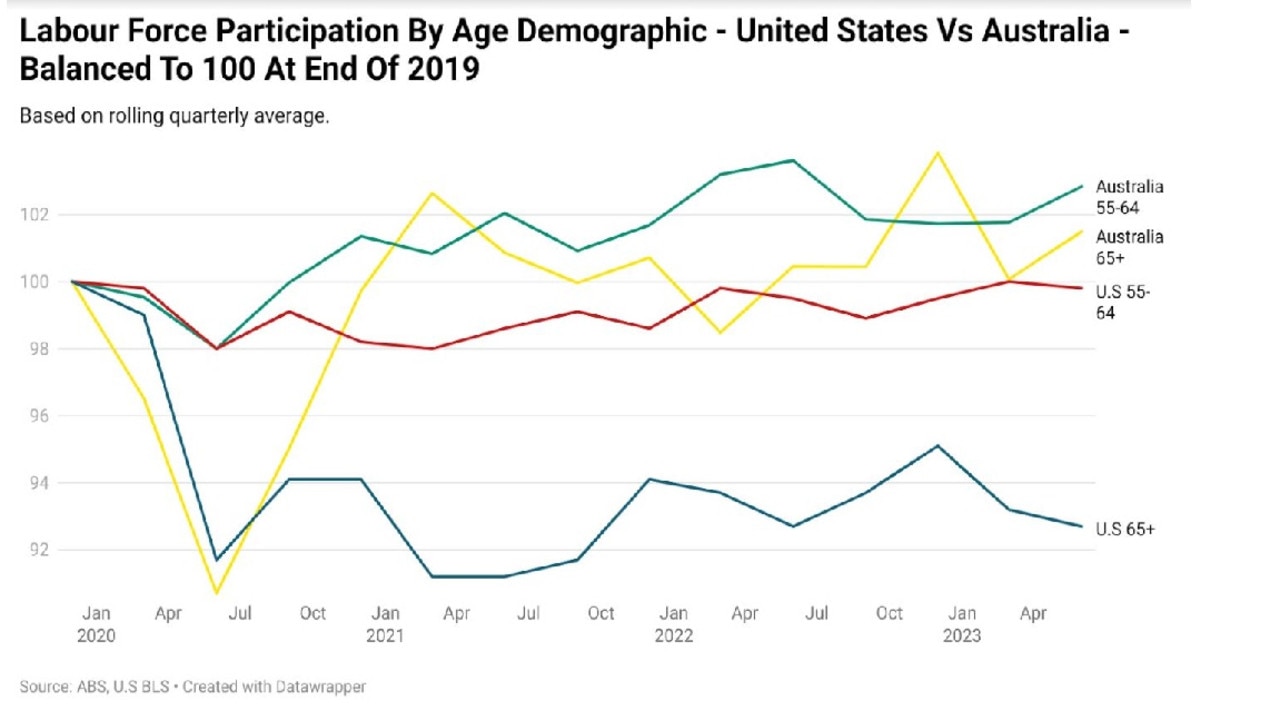Why Aussie workers are really earning so much less than Americans
Struggling to make the dollars stretch between pay days? You’re not alone – and here’s the proof Aussie employees are getting a raw deal.
ANALYSIS
Throughout the developed world, households, central banks and governments are coming to grips with high inflation for the first time in decades.
In this, Australia is no different.
In terms of G20 nations, Australia has one of the highest core inflation readings (CPI excluding food and energy) in the developed world.
Yet despite Australia having one of the highest rates of underlying inflation problems in the Western world, when it comes to wages growth, it lags well behind most of its rivals in Europe and the Americas.
There is an argument to be made that Europe has seen strong wages growth due to the war in Ukraine and the energy crisis that followed.
But what about the US – why are the wage outcomes of Australians so far behind those of Americans?

Before we go further, it is worth noting that Australia has tended to lag outcomes in the United States to a degree, but this arguably doesn’t account for the full discrepancy in wage growth outcomes.
According to data from the Atlanta branch of the US Federal Reserve, annual wages growth in the US peaked at 6.4 per cent in March. It has since dropped back a bit to sit at 6.1 per cent for June.
Meanwhile, the latest wages growth data from the ABS which covers up until the March quarter of this year has Australian wages showing annual growth of 3.7 per cent.
While the recent 8.6 per cent increase to the minimum wage and 5.75 per cent increase to the minimum award wage is likely to see Australian wages growth accelerate further, its widely considered unlikely that it will reach the lofty peaks seen in the US and parts of Europe.
Potential factors – labour force growth
Since its pre-pandemic peak in February 2020, the US labour force has grown by 1.52 per cent. The Australian labour force peaked in March 2020 and has since grown by 5.9 per cent.
On a rolling 12 month average basis, the Australian labour force is currently growing at its most rapid rate since 1989.

In July 2021, the RBA noted that high immigration was “diluting” wage growth pressures.
“In conceptual terms, one can think of this ability to tap into the global labour market for workers that are in short supply as flattening the supply curve for these workers,” RBA Governor Philip Lowe said.
“In my view, this is one of the factors that has contributed to wages being less sensitive to shifts in demand than was once the case.”
Then-Labor Immigration Spokesperson Kristina Keneally echoed Governor’s Lowe’s conclusion, stating that a growing number of experts were noting the impact of high levels of migration on Australian wages and the jobs market.
Early retirement or not
In the US, the labour force participation rate of people over the age of 65 has fallen by 7.3 per cent compared with the last data prior to the pandemic. Amid the largest government stimulus package in history and rocketing asset prices underpinned by near zero interest rates, millions of Americans chose to retire early and leave the labour force.
Given the way the US social security system functions for retirees, this is perhaps unsurprising.

Unlike the Australian system where a government pension is means tested, in the US, social security means all Americans over a certain age qualify as long as they meet the required length of working life or spousal connection.
As of the latest data, the average monthly payment was $US1782 ($A2631) per recipient. When coupled with personal retirement savings or some form of private pension plan, an early retirement can be a pretty appealing prospect for some Americans.
Meanwhile, the proportion of Americans aged 55-64 in the labour force remains at roughly the same level as prior to the pandemic.
In Australia, the picture is quite a bit different. As of the latest data, the proportion of people aged 55 to 64 in the labour force has risen by 2.8 per cent, with the proportion of those aged over 65 rising by 1.5 per cent.

Amid the exodus of older Americans from the US labour force, the effort to incentivise the workers who will replace them has driven outsized wage increase, in particular in industries defined by a significantly older median age than the average.
The outlook
While there is a relatively strong argument to be made that Australia’s wages growth is lagging the rest of the world, this doesn’t fully account for the degree that Australian wages are underperforming those in other nations.
For example, if we were to rewind US wages to where they were a year ago, they were still rising by 1.7 percentage points more than Australia’s.
The growth of the broader labour force and more Australians than ever staying in work into their golden years are factors in this underperformance, but by no means are they the only two influencing wage outcomes.
Ultimately, with the unemployment rate sitting near 50-year lows and with the economy creating an average of 35,000 jobs per month over the past year, the Albanese government needs to do some soul searching on exactly what can be done to finally get wages growth moving.
Tarric Brooker is a freelance journalist and social commentator | @AvidCommentator






